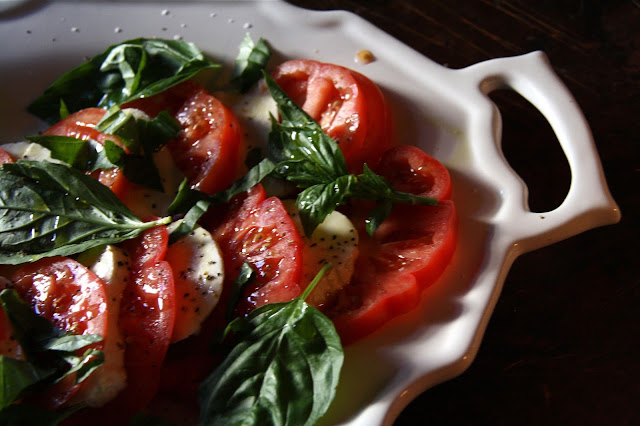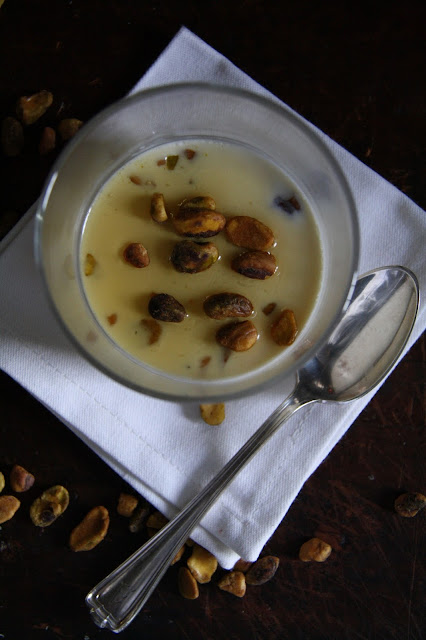Summer's astronomical start doesn't officially arrive for another week, however, meteorologically it has already steamrolled in. If this midwestern 'heatmageddon' continues at its' current pace, it is going to be a very long, hot summer. Let the whining begin! Admittedly I am what you might call a heat wimptress. The little beads of sweat covering my nighttime face as I lay in bed in a room without a cross breeze in our un-air-conditioned house remains one of my still retrievable childhood memories. Somehow I managed to survive living in house where the fan was faced to the outside (supposedly to draw the heat out). Although the remains of my aversion to hot, humid weather is now reflected in my adult beet, or rather tomato red face. The visible battle scar from my days growing up in a 'hot' house.
Summer's seasonal fruits, vegetables, and herbs are amongst my absolute favorites. One of the upsides of having to endure brutally hot and humid days is having access to the some of most incredibly flavorful bounty Mother Nature has to offer. High up on my list of summer food favorites are tomatoes.
Depending on where you live, it may be one of those salads you can, or rather should be, making for only a couple months of the year. The Caprese Salads made in the summer or early fall tastes very different than the ones made in the winter or spring months. Unless, of course, you have a fondness for those mealy, tasteless, genetically engineered things sold in grocery stores or appearing on restaurant menus (falsely) labeled as tomatoes in the middle of the winter or in early spring.
Whether you say to-may-to or to-ma-to, nothing comes close to the juicy, delicious, bursting with flavor taste of a freshly picked (from the farm or garden if you are lucky) ripe tomato. Or better yet, an heirloom tomato. Enduring the heat of the summer months just happens to be one the prices we need to pay in order to have access to ripe off the vine tomatoes.
The tomatoes available at the Farmer's Market last weekend were absolutely, 'be still my heart' beautiful. For the Caprese Salad I planned to make for a dinner with friends, the combination of heirloom and some 'variety unknown' tomatoes would make it one of those best of both tomato worlds salads.
One of the larger Italian stores near my home sells some of the best homemade, fresh mozzarella. And at prices far less than some of the other grocery stores, especially the ones specializing in fresh, organic foods! If possible, look for the fresh mozzarella floating in its' brine solution versus the prepackaged wrapped 'fresh' mozzarella for a Caprese Salad to die for. The taste difference between the two types of fresh mozzarella is akin to the difference between a 30 degree and 90 degree day.
After the tomatoes and mozzarella, you need only two other 'freshest and bestest' you can find ingredients: basil and extra-virgin olive oil. Depending on how often you use basil, grow as much of it as you possibly can! One can never have too much basil growing in one's garden.
To tear or to cut? That is the basil question. Some will say there is more flavor when you tear the basil (due to the release of its oil). Others will say a steel knife will cause some oxidation to the basil, thus affecting the coloring. But the cut-tear approach may be more about preference than exact science (especially if you use a plastic knife to cut the basil). So just do what feels right for you.
The Caprese Salad calls for thicker slices (about one-half inch) of tomatoes as well as the mozzarella. My mozzarella slices are generally cut a tad thinner than the tomato slices.
How many times have you ordered a Caprese Salad in a restaurant having at least, if not more, than a drizzle of balsamic vinegar on it? Hint: They probably are not making it with the best and/or freshest tomatoes and mozzarella available. Well, contrary to a widely held mis-conception in the United States. a genuine Italian Caprese Salad is not served with any vinegar. It is simply dressed with a high quality extra-virgin olive oil and the juices from the tomatoes. Anything more will mask the flavor of the tomatoes and mozzarella. If, for any reason you or your friends/family happen to like balsamic vinegar with your Caprese Salad, well, serve it on the side. But don't tell anyone I told you that. I do not want the Caprese Salad purists to come looking for me.
After mint mojitos and some appetizers, this Caprese Salad was the prelude to a meal of Lasagna Bolognese and Florentine Style Peas (both upcoming blog posts). And in keeping with an Italian themed meal, it ended with Honey and Pistachio Panna Cotta. If there was ever a dinner menu to both tantalize and satisfy one's visual and taste senses, this would be it. Whether or not I serve this meal again over the course next several months, I will definitely be making this Caprese Salad as often as possible. And always with the Balsamic vinegar, the one my sister brought me back from Italy, on the side.
Recipe
Caprese Salad
Serves 4 to 5
Ingredients
4-5 large ripe heirloom or vine ripened tomatoes, cut into half inch slices
3 six ounce balls of fresh mozzarella, cut into slightly less than half inch slices
10-12 basil leaves
Extra-virgin olive oil
Kosher salt and freshly ground black pepper
Optional to serve on the side: A good quality balsamic vinegar
Directions
1. Alternately layer tomatoes and mozzarella on large serving platter.
2. Sprinkle with kosher salt and pepper.
3. Generously drizzle extra-virgin olive oil over tomatoes and mozzarella.
4. Top with torn and/or cut slices of fresh basil.
5. Serve immediately.
Over the river and through the woods. Wilbour Woods, Little Compton, RI. Calm, cascading, and rippling water images.




























































